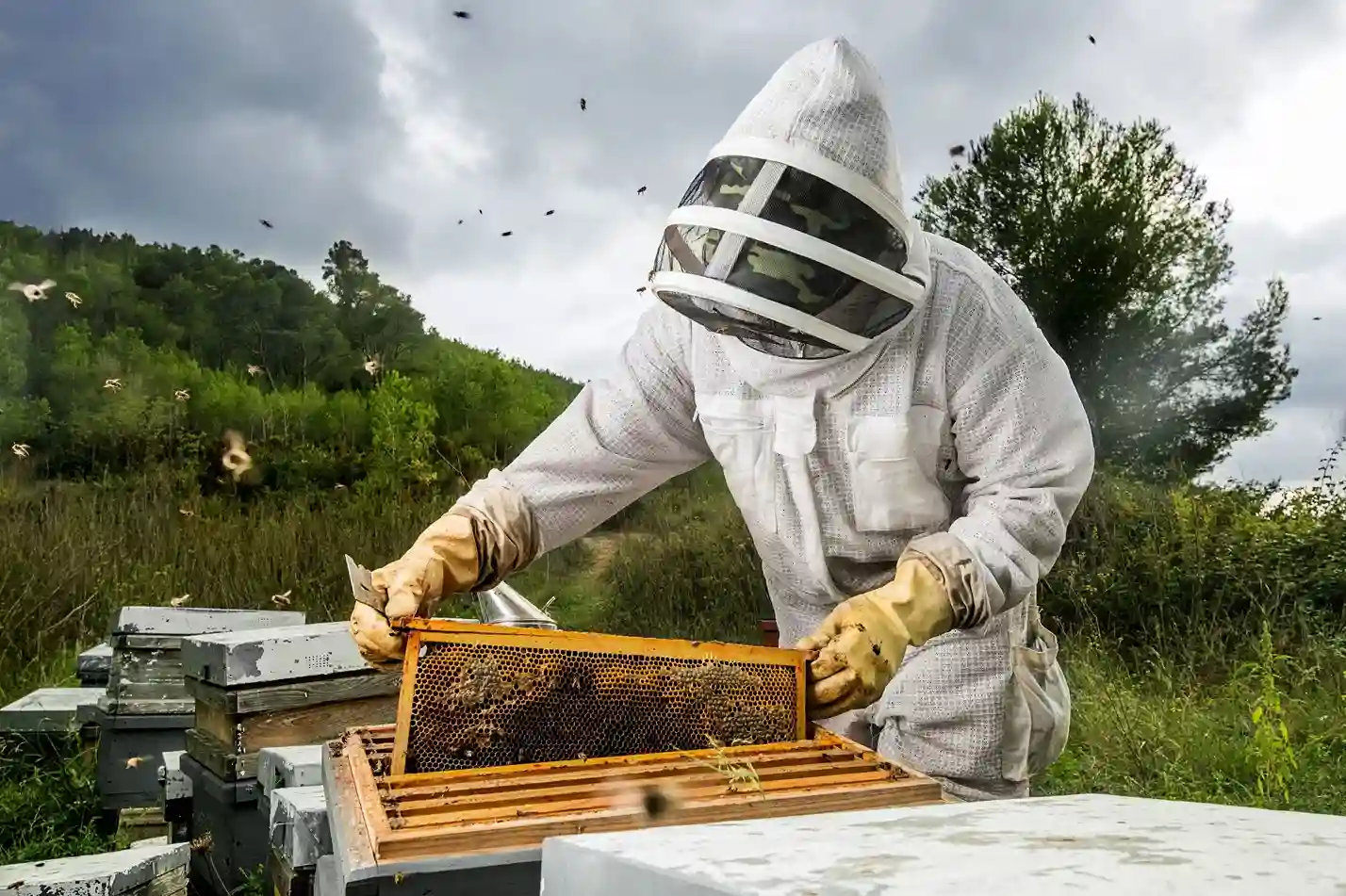The Sweet Story of Honey: A Journey into the World of Local Honey Production
Honey is the most sweet and viscous substance bees make from nectars of different flowers. Honey has a significant influence on human history, this sweet is not only used in medicine but also as a precious gift for loved ones. Since ancient times, honey has been considered very important because of its nutritional and medicinal properties and it also has cultural importance. To trade honey, traders from different parts of the world travelled and increased the value of honey. The taste and the quality of honey differ based on the region it grows and the flowers from which it collects the nectars. For example, Himalayan honey is different from the honey produced in the mountain valley of Munnar. Beekeeping is the art of local honey production, where bees are stored in special bee boxes which helps them to produce honey.
There are multiple health benefits for honey, it is used as a soothing agent during sore throat and also used in a variety of medicines. Local honey production refers to the practice of harvesting honey within a specific geographical area, typically on a small scale and often by independent beekeepers or small-scale apiaries. Local honey production is very important, sourcing from forests and nearby urban areas which promotes sustainability, supports local economics and preserves local biodiversity. By maintaining bee colonies within the community, local honey production fosters pollination of local crops, enhances ecosystem health and reduces the environmental impact associated with long-distance transportation.
Overall, local honey production embodies principles of environmental stewardship, economic resilience and social connectedness, contributing to the sustainable development of rural and urban areas alike.
In this blog post, we will discuss the origin and the importance of honey and also we will be discussing local honey production.

Basil Thomas
About the Author
Basil, the visionary behind PureLeven, seamlessly fuses his hands-on farming experience from his parents' labor. Guided by nature's lessons, Basil directly sources premium products from Kerala's farms, embodying a profound commitment to ethical commerce, sustainability, and authentic quality.
Email: purelevenexim@gmail.com
Phone/WhatsApp: +91 8075519579
The Origin of Honey
Initially, humans began to harvest wild honey from natural sources, observing the bees, and their behavior, and collecting honey from natural hives. Then around 9000 years ago humans started domesticating bees also known as beekeeping. Ancient civilizations like Egyptians have started the techniques of domesticating bees and managing bee hives.
Honey had cultural, religious, and economical significance in Greeks and Romans which helped the value of honey to grow and the beekeeping practice to spread across the world. Innovations in
beekeeping technology, such as the development of movable frame hives, increased honey production. Today, honey production remains a thriving global industry, blending traditional methods with modern advancements, while continuing to honor the rich historical legacy of this sweet and valuable commodity.
The Importance of Honey
Honey holds a significant role in human life, it is a natural sweetener packed with high amounts of carbohydrates, vitamins, minerals, and antioxidants. As the health benefits of organic honey, the antimicrobial properties of honey make it a very valuable ingredient in wound healing and a soothing remedy for cough and sore throat. It not only has medicinal properties but also supports the livelihood of rural communities providing income for beekeepers and contributing to agricultural ecosystems through pollination. Local honey is also known for allergy relief, as it has the highest medical characteristics and helps in relieving allergies. Honey is also used in culinary in many countries, mainly used as a natural sweetener and also used in many dishes from around the world. In India, honey is used in tea and it goes with almost all the dishes. In Ancient India, honey was given to infants but nowadays it is no longer given to kids less than 1 year old.
Local Honey Production: From Hive to Table
Honey production is a fascinating process orchestrated by honeybees. Here’s a simplified explanation of how honey is produced:
- 1. Foraging: Worker bees, which are female bees, venture out of the hive in search of flower nectar. They have a specialized tongue called a proboscis to collect the nectar.
- 2. Nectar Collection: When a worker bee finds a flower with nectar, she uses her proboscis to suck up the liquid and stores it in a special stomach called the honey stomach or crop.
- 3. Return to the Hive: Once the honey stomach is full, the worker bee returns to the hive where she passes the collected nectar to other worker bees through a process called trophallaxis.
- 4. Processing: Inside the hive, worker bees continue the honey-making process. They transfer the nectar from bee to bee, adding enzymes from their bodies that break down the complex sugars in the nectar into simpler sugars like glucose and fructose.
- 5. Evaporation: Worker bees then spread the nectar into thin layers within the honeycomb cells. They fan their wings over the nectar to promote evaporation, reducing the water content of the liquid.
- 6. Storage: Once the water content of the nectar is reduced to about 17-20%, the bees cap the honeycomb cell with beeswax to seal it off, creating honey. This sealed honey will serve as a food source for the bees during times of scarcity.
- 7. Harvesting: Beekeepers harvest honey by removing the honey-filled frames from the hive. They use tools to uncap the cells and extract the honey. The extracted honey is then strained to remove any remaining debris or impurities.
- 8. Packaging and Consumption: The harvested honey is packaged and made available for consumption. Depending on the floral sources visited by the bees, the honey can vary in flavor, color, and aroma, reflecting the diversity of plant species in the surrounding area.
- 9. Online Store: Pure honey is then available online for purchase. You can purchase the best quality honey from Pureleven’s store.
Supporting Local Honey Making Process
Supporting the local honey-making process carries a major importance for both the consumers and the environment. Purchasing the honey from local farmers and beekeepers will help to preserve the bees ecosystem and the bee population. Local bee farmers always make sure the bees are healthy and also prepare a healthy environment for the growth and production of honey. For local farmers, honey production is not just an income but also bees help them in their pollination process that helps them to produce more crops. Buying local honey will also help to improve the economy and living standards of local people.
Purchasing local honey will help to improve the income of local beekeepers and also it will improve the environment and the habitat of healthy bees. Furthermore, local honey production helps preserve natural habitats and promotes agricultural diversity by supporting a variety of flowering plants that bees rely on for nectar and pollen. This, in turn, enhances overall ecosystem health and resilience.
There are several ways you can purchase honey local honey online. You can visit the nearest honey shop to reach out to the honey farms and purchase honey. Also, farmers are now selling honey online platforms like pureleven.com is our online store and we are selling honey online. Pure Leven has a wide range of honey products that are ethically sourced and natural. To purchase honey at wholesale price, you can reach out to Pure Leven they are the Wholesale Organic Honey Supplier from Kerala.
Exploring Different Varieties of Honey
There is a wide variety of honey available in the market like Himalayan honey, Multiflora Honey, Stingless Honey, and many other infused honey. Himalayan honey, stingless honey, and multiflora honey are natural honey sourced directly from the honey bees. Wild honey is high-quality honey that is collected from the forest by local communities and tribal experts. Whereas infused honey are available where fruits and other extracts are infused to the honey to make the honey taste sweeter and different. Read more about different honey varieties in our page:
https://www.pureleven.com/honey-wholesale/.
Conclusion
In conclusion, our journey into the world of local honey production has revealed the multifaceted importance of supporting local beekeepers and honey producers. By choosing to support local beekeepers, we not only contribute to the preservation of bee populations and biodiversity but also stimulate local economies and promote sustainable agricultural practices. Whether enjoyed drizzled over yogurt, infused into tea, or incorporated into culinary creations, local honey invites us to connect with the natural world and embrace the richness of our local food systems. Let us continue to celebrate and support the hard work and dedication of local beekeepers, ensuring a sweet and sustainable future for generations

